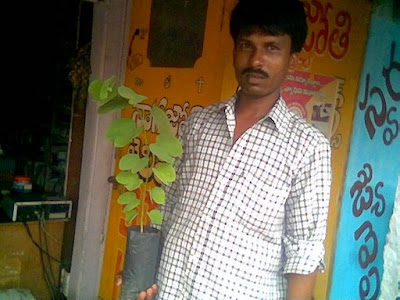Luckily for the people of the Anantpur District of Andhra Pradesh there is the Green Tree Foundation. Their goal is the re-greening of the district to provide more food and fiber for the local residents. Their additional aims are to establish more water harvesting infrastructure in the area and, on a global scale, do their part to combat global warming through carbon sequestration.
The Green Tree Foundation has surveyed the local situation to identify the problems faced by the public and used that knowledge to work out strategic solutions to those problems. The most visible strategy employed is the establishment of vegetation in and around villages.
The simple act of planting trees can increase food supply, provide shade, harvest rainfall, repair soil hydrology, increase soil health, and increase precipitation both through capture of condensation and through increased transpiration, leading to increased downwind precipitation.
The man who started this effort is Gangi Setty, a local teacher. Growing up in Andhra Pradesh, Gangi Setty is no stranger to hunger and has seen the local environment grown increasingly arid and impoverished over his lifetime. Since the founding in 2004, he has managed to put together a team of two nursery technicians, two program officers, one civil engineer, one computer operator and about 200 volunteers from locals, who help out in the field with the difficult work of land assessing and planting, to people overseas such as myself who provide technical advice and assist in grant requests.
So far the Foundation has been operating on a budget of approximately 120,000 Rupees, which has come entirely from local donation. That such fantastic results can come out of such a small budget is testament to the sensibility of the Foundation’s strategy of partnering with nature to achieve its goals.
What follows are images of the Green Tree Foundations recent tangible achievements:
Young volunteers getting an almond tree into the ground.
Nursery stock of Arjoon sadura (A.K.A. Terminalia glabra, A.K.A. Terminalia arjuna, edible seeds and the bark is mixed with milk to make a beverage), one of the Bauhinia species (depending on the species, the edible parts can include the nectar, leaves shoots flowers and flower buds, seeds and sap), almond and a plant Gangi Setty identifies as tachoma.
A village leader plants bamboo, excellent for providing food and fiber.
Shade and food are provided for this outdoor kitchen thanks to a bean-covered trellis. The Green Tree Foundation has planted more than 20,000 plants in residential kitchen gardens.
The founder, Gangi Setty, and some volunteers find a strategic microclimate for Cassia fistula (edible flowers, leaves and fruit, also a mild laxative) and Jujupus luluba. Planting on hillsides such as this helps control erosion, goes a long way towards reestablishing the local water table, provides shelter and food for wildlife, and supplies a commons area with food to help provide for the whole village.
A villager walks away with a free Bauhinia tree.
In a very clever strategy to distribute plants, this taxi driver was given saplings to give to his customers.
The foot of this hill has been planted with of Arjoon sadura (A.K.A. Terminalia glabra, A.K.A. Terminalia arjuna).
Kitchen gardens planted providing food and shade.
A Leucaena species going into a strategic microclimate. (These species have edible seeds, leaves and flowers.)
All people of all religions are welcome. Here Muslims take Bauhinia to plant at a Mosque.
Fruit trees stand on what was once barren earth.
Gangi Setty on a street that he has helped to regreen. Shade, food, erosion control and soil rehabilitation are all in place thanks to the efforts of the Green Tree Foundation’s volunteers.
This pharmacist handed out 100 productive trees to people in one day. Such strategies make the regreening effort much easier and more wide-spread.
As a birthday gift, this boy receives a food and fiber source that, with proper care, will provide for his descendants many generations down the line.
Sesbania (a nitrogen-fixing forage tree that also providing edible flowers, leaves and young fruit, and it makes an anti-tumor, anti-helminthic tea) and papaya growing in this kitchen garden.
This teacher took 50 trees to plant at the school.
A group of about 40 volunteers from the Green Tree Foundation dug pits to assist in water harvesting for 700 trees which were planted at the Yogi Vemana channel.
I greatly admire Gangi Setty and his dedicated and knowledgeable team and hope that one day I may travel to Andhra Pradesh to assist in their efforts. But with North America rapidly becoming hotter and drier (parts of the Great Lakes have fallen over 4 feet due to decreased rainfall), and our energy-hungry society facing a future with diminishing energy reserves, the day may come when we may need experienced people like Gangi Setty and his team to come and repair our damaged landscapes.
If you would like to contact the Green Tree Foundation or donate to their cause, they can be contacted at
Gangi Setty, Green Tree Foundation,Poola Bazaar,
Talupula (Post and Village) ,Anantapur Dist,
Andra Pradesh,
India, PIN: 515581
Read about my project with the Green Tree Foundation HERE


















2 comments:
What beautiful work you are doing.
Im trying to find some english-speaking permaculture contacts for my mate Ringo, who is trying to bring 'real permaculture' to fuji Eco-park. He is desperate for non-invasive bamboo, but doesn't know where to find it, and the local Japanese think he is halucinating "No clumping bamboo in Japan". He needs more permie mates. Please contact him though his blog
http://ringospermaculture.blogspot.com/
enjoy mine too:
http://www.balconyofdreams.blogspot.com
Cecilia Macaulay
Thanks. I sent a note off to Paul/Ringo to get in touch with Scott who is still living in Japan.
Post a Comment